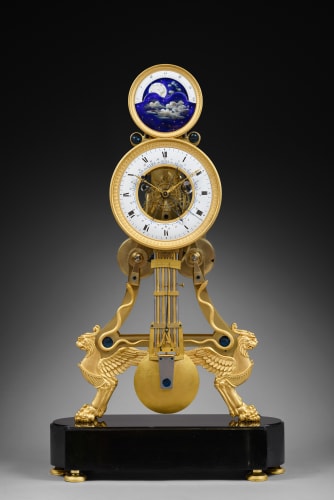Painted enamel and porcelain dials became increasingly popular during the reign of Louis XVI, reaching perfection in the hands of Joseph Coteau and Gobin Etienne (known as Dubuisson). Coteau was born in Geneva, Switzerland but is known to have practised his specialised craft in Paris. During his maturity he was established at Rue Toupée in the parish of Sant-Andre-des-Arts, where he remained until his death. At the age of 23 he produced the dial for a musical clock by Daille, horologer to Madame la Dauphine, 1763 (Wallace Collection, London). Coteau attained such repute that he only ever supplied to the most eminent horologists, including Antide Janvier (1751-1835), Robert Robin (1742-1809) and Ferdinand Berthoud (1727-1807). He is also known to have decorated pieces of jewellery.
Coteau clock dials have a characteristic style, due as much to their superior quality as to their subject. His most distinct decoration consisted of delicate numerals with small garlands of flowers but more usually with signs of the zodiac, each element worked as an individual miniature. Other dials had little or no extra ornament except for the classical Louis XVI style numerals, such as his dial for the Avignon Clock, 1771 (Wallace Collection, London), with the movement by Delunésy and elaborate gilt bronze case sculptured by Louis-Simon Boizot (1743-1809) and executed by Pierre Gouthière (1732-C.1812). At other times Coteau supplied decorative bands to accompany clock cases, such as an enamel frieze around a vase adorning one of Robert Robin's elaborate clocks, circa 1780 (Wallace Collection, London). The band, painted in grisaille, depicts the seasons personified by infants playing and is interspersed by four cameo heads. A similar clock was supplied to Marie Antoinette for Château St. Cloud. Decorative dials and their accompanying complex quality movements fell in demand during the Revolution, however Coteau was patronised by the new government to create a number of Republican ten hour dials.
It appears that Coteau never enamelled watches or small scale pieces but specialised in larger works, which were technically more complex due to shrinkage during firing. The techniques required a high degree of skill to achieve a perfect finish. Coteau experimented with various polychromes, producing a blue that was so rare and complex that few if any of his contemporaries managed to copy. The enamel paint was applied with a brush onto a copper plate and the various colours vitrified one by one in a muffle kiln. The decoration was then enhanced by delicate gilding, which after firing resulted in a matt finish, the gilding was finally burnished to restore its metallic brightness.
Coteau dials are extremly rare, they are sometimes "secretly" inscribed on the reverse, in either pen or bruch. In addition to their scarcity and their supreme quality, his dials and enamel plaques only accompanied the most complex quality mechanisms. For these reasons his work is a tru prize and significantly enhances the value of any clock. Examples of his work can be found in a number of European museums, including Mobilier National, Musee des Arts Decoratifs, Paris; Carnavelet Museum, Dijon Museum, and in London at the Wallace Collection and Victoria and Albert Museum.
Copyright by Richard Redding Ltd.
